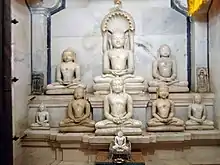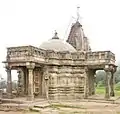Jain temples, Pavagadh
Jain temples, Pavagadh is a group of seven Jain temples located in Pavagadh Hill in the state of Gujarat. These temples are part of the UNESCO World Heritage Site of Champaner-Pavagadh Archaeological Park.
| Jain temples, Pavagadh | |
|---|---|
.jpg.webp) Parshvanatha temple | |
| Religion | |
| Affiliation | Jainism |
| Sect | Digambara |
| Deity | Rishabhanatha, Parshvanatha, Chandraprabha, Suparshvanatha |
| Festivals | Mahavir Janma Kalyanak |
| Location | |
| Location | Pavagadh, Gujarat |
| Geographic coordinates | 22°29′05″N 73°32′02″E |
| Architecture | |
| Creator | Vastupala |
| Date established | 13th century |
| Temple(s) | 7 |
| Official name: Champaner-Pavagadh Archaeological Park | |
| Criteria | Cultural: (iii)(iv)(v)(vi) |
| Designated | 2004 (session) |
| Reference no. | 1101 |
Jain tradition
Pavagadh hill is considered one of the four sacred regions where moksha can be attained.[1]
History
The Pavagadh temples dates back to the 13th century.[2]
Temples
The Pavagadh temples are famous for their architecture and are also part of the UNESCO World Heritage Site of Champaner-Pavagadh Archaeological Park.[3][4][5] Pavagadh has three Jain temples complexes that includes a total of seven Jain temples, a dharamshala and an old-age home.[1] The three Jain complexes are Bavanderi or Naulakhi temples, Chandraprabha and Suparshvanatha temple and group around Parshvanatha temple. Bavanderi Naulakhi temples are the ruins of subsidiary shrines of a once large Chaumukhi temple with entrances in four cardinal direction. The pillars inside the temple having carvings that bear a resemblance to Luna Vasahi. Chandraprabha and Suparshvanatha temples are two small temples built near Kalika Mata temple. Parshvanatha temple is the main temple in this group and is surrounded by ruins of small temples.[6]
These temples are visited by over 22 lakh visitors annually with 1 lakh devotees visiting daily during navaratri fair.[7][8][3]
Gallery
.jpg.webp) Carving of Jain Tirthankara on wall
Carving of Jain Tirthankara on wall Main vedi Parshvanatha temple
Main vedi Parshvanatha temple Chandraprabha temple
Chandraprabha temple Suparshvanatha temple
Suparshvanatha temple
References
Citation
- Ruggles & Silverman 2009, p. 84.
- Shukla 2009.
- Desai 2007, p. 177.
- UNESCO 2004.
- O'Donnell 2004, p. 51.
- Sompura 1968, pp. 218–219.
- ASI 2004, p. 60.
- Abram et al. 2013, p. 678.
Book
- Abram, David; Edwards, Nick; Ford, Mike; Jacobs, Daniel; Meghji, Shafik; Sen, Devdan; Thomas, Gavin (2013). The Rough Guide to India. Rough Guides. ISBN 9781409342618.
- Desai, Anjali H. (2007). India Guide Gujarat. India Guide Publications. ISBN 978-0-9789517-0-2.
- Ruggles, D. Fairchild; Silverman, Helaine (2009). Intangible Heritage Embodied. Humanities, Social Sciences and Law. Springer Science & Business Media. doi:10.1007/978-1-4419-0072-2. ISBN 978-1-4419-0072-2.
- Sompura, Kantilal F. (1968). The Structural Temples of Gujarat, Upto 1600 A.D. Vol. 4. Gujarat University.
Web
- O'Donnell, Patricia M. (2004). "Learning from World Heritage: Lessons from 'International Preservation & Stewardship of Cultural & Ecological Landscapes of Global Significance', the 7th US/ICOMOS International Symposium". The George Wright Forum. George Wright Society. 21 (3): 41–61. JSTOR 43597911. Retrieved 22 June 2022.
- Shukla, Shubhlakshmi (10 March 2009). "ASI to restore 12th century Jain temple at Panchmahals soon". The Indian Express.
- "Champaner-Pavagadh Archaeological Park" (PDF). Archaeological Survey of India. 7 July 2004.
- "Champaner-Pavagadh Archaeological Park". UNESCO. 2004.
External links
![]() Media related to Jain temples on the Pavagad hill at Wikimedia Commons
Media related to Jain temples on the Pavagad hill at Wikimedia Commons